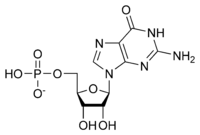User:Blandine Velut/Sandbox
From Proteopedia
| Line 17: | Line 17: | ||
| - | '''GTase domain | + | '''GTase domain''' |
The GATase domain, stretched from residue 27 to residue 216, is composed of a single structural domain. It is constituted of a central β-sheet surrounded by several α-helices. It contains <scene name='75/750228/Triad/1'>the catalytic triad</scene> composed of residues Cys104, His190, and Glu192. | The GATase domain, stretched from residue 27 to residue 216, is composed of a single structural domain. It is constituted of a central β-sheet surrounded by several α-helices. It contains <scene name='75/750228/Triad/1'>the catalytic triad</scene> composed of residues Cys104, His190, and Glu192. | ||
| - | '''Synthetase domain | + | '''Synthetase domain''' |
<scene name='75/750228/Synthetase_domain/1'>The synthetase domain</scene>, stretched from residue 217 to residue 693, can be divided into three different sub-domains: an ATP pyrophosphatase domain (ATPPase domain) and two dimerization domains D1 and D2. | <scene name='75/750228/Synthetase_domain/1'>The synthetase domain</scene>, stretched from residue 217 to residue 693, can be divided into three different sub-domains: an ATP pyrophosphatase domain (ATPPase domain) and two dimerization domains D1 and D2. | ||
| Line 61: | Line 61: | ||
The presence of free Mg2+ is essential for activation of the GMP synthetase and a complex between ATP and Mg2+ can be formed but MgATP2− alone is not sufficient for catalysis. Moreover, the total chelation of free Mg2+ by ATP results of inactivation of the enzyme. | The presence of free Mg2+ is essential for activation of the GMP synthetase and a complex between ATP and Mg2+ can be formed but MgATP2− alone is not sufficient for catalysis. Moreover, the total chelation of free Mg2+ by ATP results of inactivation of the enzyme. | ||
| - | ''' | + | '''Inhibitors''' |
| - | -Decoyinine is an uncompetitive inhibitor<br />-Inorganic pyrophosphate is the most effective inhibitor and it is competitive toward ATP<br />-Psicofuranin is known to inhibit this enzyme.<br />-6-Diazo-5-oxo-L-norleucine (DON) is a glutamine antagonist | + | -'''Decoyinine''' is an uncompetitive inhibitor<br />-Inorganic pyrophosphate is the most effective inhibitor and it is competitive toward ATP<br />-'''Psicofuranin''' is known to inhibit this enzyme.<br />-6-'''Diazo-5-oxo-L-norleucine (DON)''' is a glutamine antagonist |
| + | - '''Acivicin''' is an analog of glutamine that irreversibly inhibits GMPS and other glutamine-dependant amidotransferases | ||
| - | == Relevance | + | |
| + | == Relevance and Medical implications == | ||
Revision as of 20:45, 26 January 2017
2vxo
HUMAN GMP SYNTHETASE
An ample supply of nucleotides is essential for many life processes, including cell maturation, cell division and transmission of the genetic information. Indeed, nucleotides are the activated precursors of nucleic acids, but they also are major energy carriers, and precursors for the synthesis of nucleotide cofactors. Among these molecules is the guanosine monophosphate (GMP), also known as 5'-guanidylic acid or guanylic acid, a nucleotide that is used as a monomer in RNA. Like other nucleotides, GMP can be synthesized by 2 main pathways : de novo pathway and salvage pathway. De novo synthesis of nucleotide involves several enzymatic reaction and enzymes. Here, we will focus on the final step of the process, which is catalyzed by a glutamine amidotransferase called GMP synthetase (GMPS; E.C. 6.3.5.2). This enzyme belongs to the family of ligases, and catalyzes the conversion of xanthine monophosphate (XMP) to GMP in the presence of glutamine and ATP. [1]
| |||||||||||
References
- ↑ Oliver JC, Linger RS, Chittur SV, Davisson VJ. Substrate activation and conformational dynamics of guanosine 5'-monophosphate synthetase. Biochemistry. 2013 Aug 6;52(31):5225-35. doi: 10.1021/bi3017075. Epub 2013 Jul, 23. PMID:23841499 doi:http://dx.doi.org/10.1021/bi3017075
- ↑ http://www.uniprot.org/uniprot/P49915
- ↑ http://www.uniprot.org/uniprot/P49915
- ↑ Lui MS, Kizaki H, Weber G. Biochemical pharmacology of acivicin in rat hepatoma cells. Biochem Pharmacol. 1982 Nov 1;31(21):3469-73. PMID:7150366
- ↑ Oliver JC, Linger RS, Chittur SV, Davisson VJ. Substrate activation and conformational dynamics of guanosine 5'-monophosphate synthetase. Biochemistry. 2013 Aug 6;52(31):5225-35. doi: 10.1021/bi3017075. Epub 2013 Jul, 23. PMID:23841499 doi:http://dx.doi.org/10.1021/bi3017075
- ↑ Pegram LD, Megonigal MD, Lange BJ, Nowell PC, Rowley JD, Rappaport EF, Felix CA. t(3;11) translocation in treatment-related acute myeloid leukemia fuses MLL with the GMPS (GUANOSINE 5' MONOPHOSPHATE SYNTHETASE) gene. Blood. 2000 Dec 15;96(13):4360-2. PMID:11110714
- ↑ Rodriguez-Suarez R, Xu D, Veillette K, Davison J, Sillaots S, Kauffman S, Hu W, Bowman J, Martel N, Trosok S, Wang H, Zhang L, Huang LY, Li Y, Rahkhoodaee F, Ransom T, Gauvin D, Douglas C, Youngman P, Becker J, Jiang B, Roemer T. Mechanism-of-action determination of GMP synthase inhibitors and target validation in Candida albicans and Aspergillus fumigatus. Chem Biol. 2007 Oct;14(10):1163-75. PMID:17961828 doi:http://dx.doi.org/10.1016/j.chembiol.2007.09.009
- ↑ Faesen AC, Dirac AM, Shanmugham A, Ovaa H, Perrakis A, Sixma TK. Mechanism of USP7/HAUSP activation by its C-terminal ubiquitin-like domain and allosteric regulation by GMP-synthetase. Mol Cell. 2011 Oct 7;44(1):147-59. PMID:21981925 doi:10.1016/j.molcel.2011.06.034


